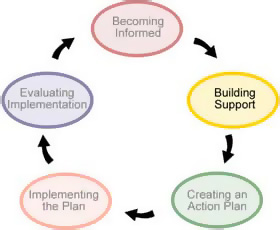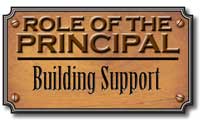How can Mr. Irwin build support for adopting the RTI approach at Mayflower Elementary?
Page 4: Be an Effective Leader
 The second stage in the process of school-wide change is building support. At this stage, it is critical for Mr. Irwin, as the principal, to lead. Principals who are effective leaders proactively build support within their school communities to initiate change for improving student outcomes.
The second stage in the process of school-wide change is building support. At this stage, it is critical for Mr. Irwin, as the principal, to lead. Principals who are effective leaders proactively build support within their school communities to initiate change for improving student outcomes.
Click below to hear Pearl Sims describe the various qualities of an effective leader (time: 1:13).

Transcript: Pearl Sims, PhD
What a really effective leader has to have is effective followers. And the real role of a leader is to help people see the true choices in front of them and to have the skills to weigh those choices—helping them to learn what those choices are and then helping to call forth in them the real strength and will to act on their own. I think the other thing that an effective leader really does is modeling learning, and that that is of such value that I welcome you in to my learning space so we can learn together. It’s also the humility that says, “I have some things to teach and some things to learn.” I think they also have to be really willing to be accountable for their actions. And when I know that there are actions I cannot do alone, am I willing to share my power, share my resources in order to help you be even more effective than I will be? But that means a leader also has to know where I’m weak and not be afraid of the strength the other people bring to the table.
Activity
There are numerous ways to characterize leadership style. This activity allows school leaders to examine their own. Click here to complete a quick survey to help determine if your leadership style lends itself to collaboration with other school personnel.
Activity: The X-Y Scale

| 1 | 2 | 3 | 4 | ||
| 1 | Closely supervise school personnel to get better work from them |
|
|
|
|
| 2 | Set goals and objectives for school personnel and sell them on the merits of my plans |
|
|
|
|
| 3 | Set up controls to ensure that school personnel are getting the job done |
|
|
|
|
| 4 | Encourage school personnel to set their own goals and objectives |
|
|
|
|
| 5 | Make sure that school personnel’s work is planned out for them |
|
|
|
|
| 6 | Check with school personnel daily to see if they need any help |
|
|
|
|
| 7 | Step in as soon as reports indicate that the job is slipping |
|
|
|
|
| 8 | Push school personnel to meet schedules if necessary |
|
|
|
|
| 9 | Have frequent meetings to keep in touch with what is going on |
|
|
|
|
| 10 | Allow school personnel to make important decisions |
|
|
|
|
Note. From Educational leadership: A problem-based approach (pp. 192–193), by W. G. Cunningham and P. A. Cordeiro, 2006, Boston, MA: Pearson Education. Copyright 2006 by Pearson Education. Reprinted with permission. Data for table adapted from The human side of enterprise, by D. McGregor, 1960, New York: McGraw-Hill. Copyright 1960 by McGraw-Hill. Adapted with permission.
Your score is 0
The highest score you can receive on this scale is a 10. High scores, 7 and above, indicate a Y. Y refers to a collaborative leadership style in which leaders motivate school personnel by encouraging them and recognizing their achievements. Individuals who display this leadership style also promote personal growth and development of school personnel and trust them to behave conscientiously.
Low scores, 4 and below, indicate a X style of leadership. X is a style of leadership in which leaders make decisions independently and expect school personnel to support the decision and perform any required action.
9 – 10
7 – 8
5 – 6
Strong Y beliefs
Y beliefs
Mild X beliefs
3 – 4
0 – 2
X beliefs
Strong X beliefs
(Close this activity)
As a school leader, Mr. Irwin has set a goal to develop and share a vision for Mayflower Elementary that encourages school personnel to support school-wide change, such as adopting the RTI approach. In this way, he can maximize the probability that the school will implement RTI effectively. To build support, Mr. Irwin will:
- Identify a group of individuals who represent the varied interests at the school
- Present a case for making the school-wide change to this representative group
 Building support among this group may require Mr. Irwin to coordinate multiple meetings. If this small group agrees that RTI could improve outcomes for the students at Mayflower Elementary, the group will be instrumental in building momentum for the school-wide change. This group will support the RTI vision by communicating with colleagues, by identifying potential questions and addressing concerns, and by researching the approach to gain more information about the impact for students and the school.
Building support among this group may require Mr. Irwin to coordinate multiple meetings. If this small group agrees that RTI could improve outcomes for the students at Mayflower Elementary, the group will be instrumental in building momentum for the school-wide change. This group will support the RTI vision by communicating with colleagues, by identifying potential questions and addressing concerns, and by researching the approach to gain more information about the impact for students and the school.
 In the building support stage, principals share ideas with key individuals within the school community in order to improve outcomes for students.
In the building support stage, principals share ideas with key individuals within the school community in order to improve outcomes for students.